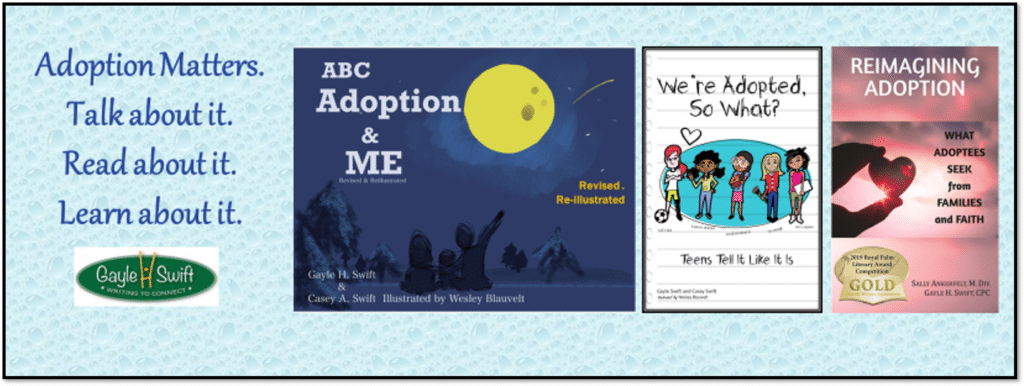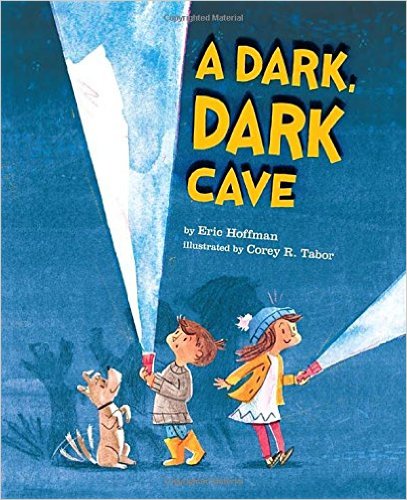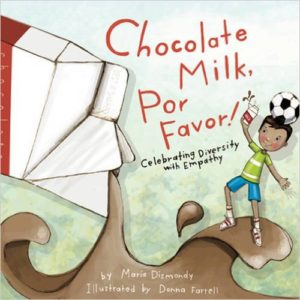 Because this is a presidential election year, households are viewing/listening to more news coverage than ever. Children notice the argumentative attitude displayed by many of the “talking heads” delivering their personal spin on the latest political firestorm.
Because this is a presidential election year, households are viewing/listening to more news coverage than ever. Children notice the argumentative attitude displayed by many of the “talking heads” delivering their personal spin on the latest political firestorm.
Although children don’t truly comprehend what is happening they certainly recognize the angry tenor of the discussions. Many kids worry about how these events will affect them, their families, communities and our country. These books address the experience of immigration and do a wonderful job of fostering empathy and recognizing the courage required to begin a new life whether in a foreign country or in a new family.
Chocolate Milk, Por Favor written by Maria Dismondy and charmingly illustrated by Donna Farrell, presents the story primarily from Johnny’s point of view. He fears being displaced as his class “makes room” a new student; Readers also see Gabe’s perspective as the new student. Johnny acts out his fears through hostility but his classmates follow their teacher’s suggestion and help him learn how to fit in. While Gabe and Johnny do not speak the same language, they do share a love of soccer. Sport succeeds in breaking down barriers and mistrust.
I like how this book depicts many different reactions to the immigrant student’s arrival. This feels more believable. It also shows how Gabe and his classmates strive to communicate even though they don’t speak one another’s language. What they have in common–as kids, students and soccer players–outweighs the differences that divide them.
The book is based on the experiences of one of Maria Dismony’s students. This is a wonderful story because it portrays the situation from both sides. Children can easily discern the message of friendship and community at the core of the story: “to have a friend is first to be a friend.” It includes discussion questions to explore before and after reading the book as well as tips for English language learners. Chocolate Milk, Por Favor is a gem, especially when paired with the next story.
 AQ Lens: For adopted children this book can easily tap into feeling alien as they enter their new world (their new family.) In some families they literally do not speak the same language. In other’s, their lack of shared experience and mutual history divides them. The challenge of learning to understand and trust one another rings true.
AQ Lens: For adopted children this book can easily tap into feeling alien as they enter their new world (their new family.) In some families they literally do not speak the same language. In other’s, their lack of shared experience and mutual history divides them. The challenge of learning to understand and trust one another rings true.
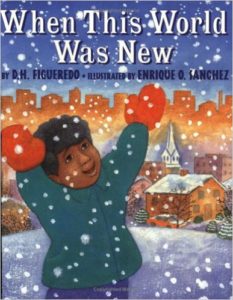 When This World Was New is written by D. H. Figueredo and illustrated by Enriqe O. Sanchez. This story follows Danilito on his journey from his tropical island homeland to America a place where he soon discovers has a magic of its own: snow! As Danilito soars over the ocean he leaves behind his familiar world. He worries about life in his new country, a place where doesn’t speak the language, where everything is foreign and unfamiliar, where the roads are thronged with traffic and the building soar into the sky. How will he ever feel at home here?
When This World Was New is written by D. H. Figueredo and illustrated by Enriqe O. Sanchez. This story follows Danilito on his journey from his tropical island homeland to America a place where he soon discovers has a magic of its own: snow! As Danilito soars over the ocean he leaves behind his familiar world. He worries about life in his new country, a place where doesn’t speak the language, where everything is foreign and unfamiliar, where the roads are thronged with traffic and the building soar into the sky. How will he ever feel at home here?
Danilito worries about his mother who is ill and his father who needs a job to provide for the family and get Danilito’s mother the health care she needs. He worries about school. How will he learn when he doesn’t speak English? How will he find the bathroom? Will he make friends?
Danilito’s father understands his sons fears. On Dani’s dreaded first day of school, Papi awakens him and helps him to dress. His dad wears unfamiliar clothes: heavy pants, sweater, a jacket and scarf. Papi helps Dani don similar clothing, soothing Danilito’s fears throughout the procedure. Then, they peek out the window. The world has been transformed. A layer of thick, white snow cloaks the ground, the trees, everything. “The parked cars had become polar bears.” Father and son go outside and experience this wonder together. They learn how to walk in the dense powder, to taste the icy flakes and to savor the silence. Buoyed by this magic morning, Danilito and his father feel ready to begin their momentous day.
When This World Was New does a superb job of immersing readers in the boy’s feelings. All of us know how it feels to be overwhelmed, frightened and reluctant to confront new situations, people and challenges. Anyone who has experienced snow knows the magical transformation fresh snow brings to the world. Sanchez’s illustrations perfectly suit the mood of the book and the image-rich text brings the day to life for those who have not.
 AQ Lens: For adopted children this book can offer similar insights to Chocolate Milk, Por Favor but through more of a first person lens. This will likely feel more intense and resonate more intensely with the parallels to their own experiences of entering the world of a new family. Be attentive to their mood as you share this book. Invite them to make the “connection” to their own life but do not press the issue if they resist. Wait until another time to revisit the book and offer another chance to discuss it.
AQ Lens: For adopted children this book can offer similar insights to Chocolate Milk, Por Favor but through more of a first person lens. This will likely feel more intense and resonate more intensely with the parallels to their own experiences of entering the world of a new family. Be attentive to their mood as you share this book. Invite them to make the “connection” to their own life but do not press the issue if they resist. Wait until another time to revisit the book and offer another chance to discuss it.
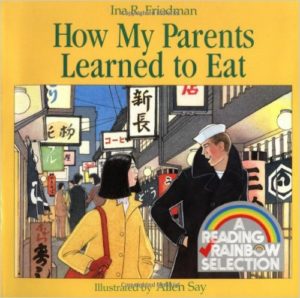 How My Parents Learned to Eat by Ina R. Friedman and illustrated by Allen Say looks at the immigrant experience from a unique angle: a boy wonders how his American dad and his Japanese mother learned to share one another’s worlds. He does this by focusing on the differences in foods and eating utensils and the roller coaster of feelings they probably had as each made “assumptions” about the other’s thoughts and emotions. As in the other two stories reviewed in this post, characters are divided by language yet still mange to communicate–although after some miscues and erroneous “translations.” Reading Rainbow selected the book as a featured story.
How My Parents Learned to Eat by Ina R. Friedman and illustrated by Allen Say looks at the immigrant experience from a unique angle: a boy wonders how his American dad and his Japanese mother learned to share one another’s worlds. He does this by focusing on the differences in foods and eating utensils and the roller coaster of feelings they probably had as each made “assumptions” about the other’s thoughts and emotions. As in the other two stories reviewed in this post, characters are divided by language yet still mange to communicate–although after some miscues and erroneous “translations.” Reading Rainbow selected the book as a featured story.
 AQ Lens: For adopted children this book can offer a less intensely associated experience being a “foreigner.” This time instead of presenting it from a child’s point of view (which tends to make it easier to identify with and place themselves in their experience,) the story unfolds through the adults. This places an extra layer o emotional distance which may make it more comfortable for the child to explore the ideas and emotions the story raises.
AQ Lens: For adopted children this book can offer a less intensely associated experience being a “foreigner.” This time instead of presenting it from a child’s point of view (which tends to make it easier to identify with and place themselves in their experience,) the story unfolds through the adults. This places an extra layer o emotional distance which may make it more comfortable for the child to explore the ideas and emotions the story raises.

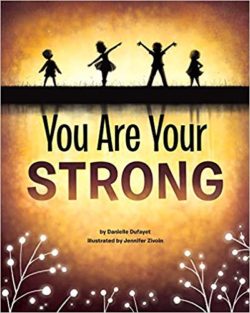 Emotions reflect the gamut of human experience. They include a spectrum from frigid despair, to scalding anger, immobilizing fear, to unbridled joy. Every emotion has value, serves a purpose, and bears expressing. Sometimes emotions can disrupt or overwhelm. Regulating emotions takes skill even for adults. Children benefit from learning how to express and manage emotions in a safe and healthy way, how to name them, how to talk about them, and how to express them. This ability is an important element of Emotional Intelligence.
Emotions reflect the gamut of human experience. They include a spectrum from frigid despair, to scalding anger, immobilizing fear, to unbridled joy. Every emotion has value, serves a purpose, and bears expressing. Sometimes emotions can disrupt or overwhelm. Regulating emotions takes skill even for adults. Children benefit from learning how to express and manage emotions in a safe and healthy way, how to name them, how to talk about them, and how to express them. This ability is an important element of Emotional Intelligence. Adoption-Attunement Lens– Even if they are not involved in an open adoption, all adopted children have both a birth family and an adopted family. Research reveals that adopted children think about and fantasize about their birth parents. They wrestle with questions about what specifically caused them to be placed for adoption. Unsurprisingly, adoptees have strong, complicated emotions about this reality. Reading this book with a parent can logically segue into discussions about these feelings. Such conversations provide children with essential support and can help clear up any misconceptions that blame themselves for their adoption.
Adoption-Attunement Lens– Even if they are not involved in an open adoption, all adopted children have both a birth family and an adopted family. Research reveals that adopted children think about and fantasize about their birth parents. They wrestle with questions about what specifically caused them to be placed for adoption. Unsurprisingly, adoptees have strong, complicated emotions about this reality. Reading this book with a parent can logically segue into discussions about these feelings. Such conversations provide children with essential support and can help clear up any misconceptions that blame themselves for their adoption. 